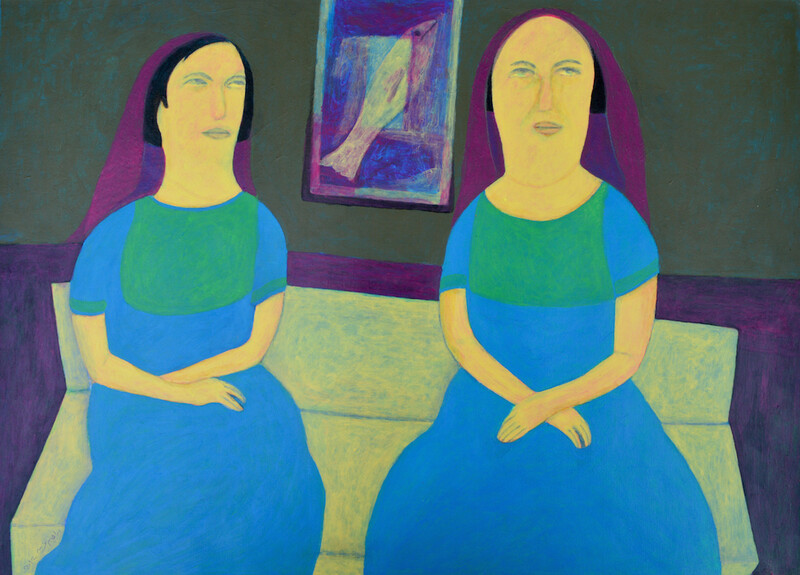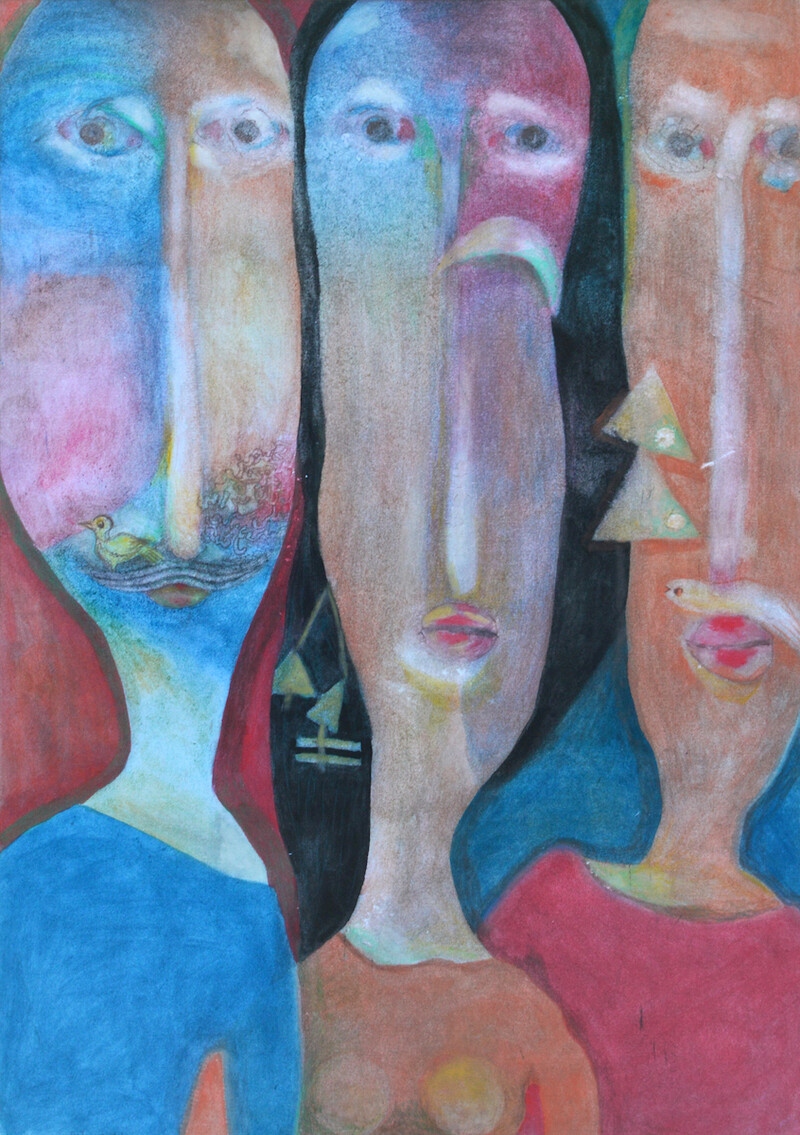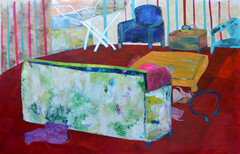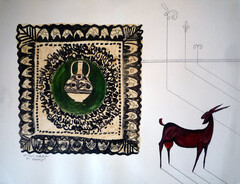The Electronic Intifada 17 June 2016

“The Loud Silence II,” Ibrahim Al Mozain, acrylic on paper, 40x55cm, 2012.
The vibrant and complex works of Gaza-born artist Ibrahim Al Mozain were on exhibit at his first solo Ramallah show in the West Bank city’s Zawyeh Gallery this month.
Al Mozain was born in Rafah refugee camp in 1961 and educated at the School of Visual Theatre in Jerusalem. He currently lives and works in Ramallah, where he remains involved in Palestinian theatre as a director and set designer.
The Loud Silence gathers into one place three distinct phases of the artist’s larger-than-life paintings, which together tell a complicated story of loss and collective transformation.
The layering of symbols brings together poignant Palestinian imagery — martyrs posters, women in traditional robes, and hints of village scenery — and questions gender and sexuality (the mustachioed women, in particular) amid bright, sometimes screaming, colors.
Weaving in an ancient Greek myth of sex, blindness and prophecy, the works revive and reimagine perennial symbols in Palestinian art. From the mother, to the martyr, and the idyllic landscape, Al Mozain’s work asks: what do these images symbolize today?
Agonized waiting

“Untitled” by Ibrahim Al Mozain, watercolor on paper, 64x48cm, 2005.
Beginning with early explorations of the body, Al Mozain makes a first study of faces. These figures haunt each and every canvas, and once perfected are used within revealing reinterpretations of what are now familiar Palestinian symbols of waiting women, hilly landscapes and hero-fighters.
Al Mozain’s six-panel “Solitude” (2009) perhaps best exemplifies the early work on layered themes. Ghostly faces of simple and almost identical figures, represented by a shadowy silhouetted bust, peer out, separated from each other by the empty space between the canvases. Mouths are closed, except for one in mid-scream, and even when two or three figures float into the frame, they are alone with no sign of an interaction beyond bodies in space, eyes looking past the viewer.
Expressions of connection-in-separation and agonized waiting characterize this early phase, and the shadowy figure comes to form the basic outlines of all the characters who appear in the later works of the collection.
Bearing mustaches and at other times not, sometimes a woman, sometimes a man, the now ubiquitous solitary face makes the perfect canvas for Al Mozain’s exploration of layered dualities.
The transition from study to theme is played out in Al Mozain’s 2012 works.
The child “Hero” (2012), playing on the shores of Gaza, a boat listing behind him at sea, shadows the face of the women holding boats and fish in “The Loud Silence I” (2012). These women offer the fruits of the sea as the child watches — a new Handala. But unlike Naji al-Ali’s iconic cartoon of a refugee boy perpetually facing away from the page toward an unseen Palestine, Al Mozain’s hero faces the viewer.
The child’s figure stands in not only for the loss of a homeland writ large as al-Ali’s Handala does, but for Al Mozain the figure of the boy becomes the template for each and every one of his later characters. Rather than a boy experiencing perpetually the loss of a homeland, these figures embody the loss and own it as they recreate national mythologies to better represent the present day.
Al Mozain’s silent figure is transfigured in the subsequent canvases of “The Loud Silence” sequence. First he stands looking at the viewer, but in “The Loud Silence II” he disappears, referred to by the image of the fish hung on the wall of the salon occupied by two waiting women. They wait for the fish that the “hero” bears witness to in the first of the canvases.
In “The Loud Silence III,” the framed image of the fish transforms into the framed image of the martyr hung on a wall inhabited by a man and woman. In the foreground of this last panel in the series, the face of the child (who is now the fish and the martyr) reappears, hovering in the foreground.
Mythical prophecy

“Teresias” by Ibrahim Al Mozain, oil on canvas, 120x75cm, 2012.
The figure makes yet another transformation as it is built into the artist’s thinking on the Greek figure of Tiresias in a series of works beginning with “Underworld I” and “Underworld II” (both 2009) to “Jealousy” (2014).
In these, the recurrent face becomes that of the mythological character. Turned from man into woman and back again, Tiresias, the blind prophet, embodied multiple dualities as the man/woman made his/her way through a Greek world of myth, gods and creatures with the strange ability to understand the song of birds. In his canvases, Al Mozain plays with the elements of the myth by painting full-figured women, birds on shoulders and thick black mustaches on their faces.
In the myth as well as the canvases, figures come to represent a series of previously unconnected symbols: for Tiresias, the male and the female, the blind and the sighted. For the face of Al Mozain, distinctions between what is traditionally present in Palestinian art becomes inverted, sublimated into what was once absent but now made visible.
The waiting woman becomes, in “Tainted Spring” (2014) and “Desire” (2014), the waiting man. In the songbirds that dot canvases of many works in the collection the natural landscape is made to speak, not only symbolizing traces of the past but mythical prophecy for the future.
These layered and inverted symbols push viewers to think beyond static categories, from those of gender to the at times rigid construct of national imagery. They demand the questions: what happens to Palestinian imagery when the waiting woman becomes the waiting man? How does loss change when it must incorporate these shifts in symbols, the disappearance of categories?
Then, most alluringly: what sort of productive myth emerges from these layered questions, and how might that myth see Palestine and Palestinians through the coming phases?
All images copyright the artist and courtesy of Zawyeh Gallery.
Nora Parr holds a PhD in Arabic Literature from the School of Oriental and African Studies (SOAS), University of London, and is currently in Jerusalem as a Research Fellow at the Kenyon Institute.





